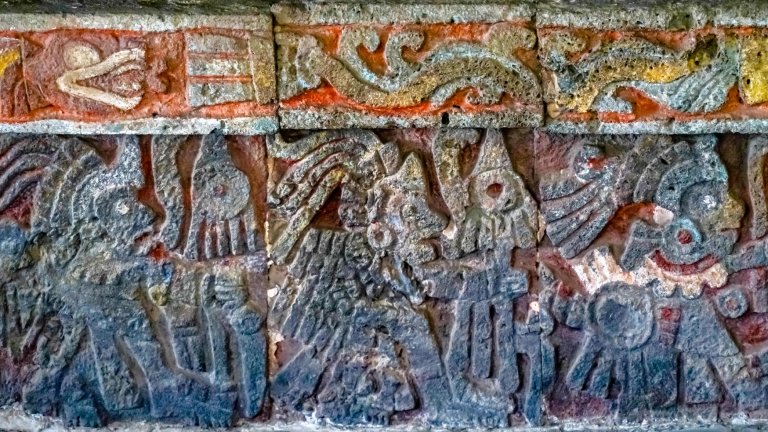Eduardo Matos Moktesuma led the excavations of the Great Aztec Temple in Mexico City – a remarkable event in the world of archeology
Renowned Mexican archaeologist Eduardo Matos Moktesuma, who led the excavations of the Great Aztec Temple in Mexico City, is the winner of this year’s Princess of Asturias award in the social sciences, the Associated Press reported.
“Eduardo Matos Moktesuma and his work are an inspiration for future generations of social scientists and citizens” states the Foundation for prestigious awards
Excavations at the 16th-century sanctuary, which was discovered by chance in 1978, below the city’s main square, are a landmark event in the world of archeology. For more than 20 years, scientists have continued their search and attracted huge public interest.
These excavations, as well as other studies, are “examples of the development of archeology and fruitful dialogue with the past, between cultures and between human and social sciences,” said a statement from the foundation named after the heiress to the Spanish throne, Princess Leonor. .
The foundation also points to the “exceptional intellectual precision” of the 81-year-old Moktesuma, who is the author of several books as well as more than 500 articles, catalogs and manuals.
“Because of his intelligence, ability to communicate and his social commitment, Eduardo Matos Moktesuma and his work are an inspiration to future generations of social scientists and citizens,” the foundation said in a statement.
The annual “Princess of Asturias” award, with a cash prize of 50,000 euros, is presented in eight categories, including art and sports.
The prize is among the most prestigious in the Spanish world.
The award ceremony is usually held in October in the northern Spanish city of Oviedo.
Recall that in the summer of 2021, Mexico regained 34 archaeological artifacts from Germany
Among the artifacts are objects from different time periods and cultures – anthropomorphic clay figures, a stone mask of the Olmec civilization from the period 1200-600 BC, a three-legged clay vessel of the Maya from 1000-1520.
Mexico has received 34 archeological artifacts from the pre-Columbian era, which were returned voluntarily by private collectors in Germany, the DPA reported, citing the country’s foreign ministry.
“Two German citizens contacted our embassy in Berlin to express their desire to return archeological objects owned by their families,” said Alejandro Celorio, the foreign minister’s legal adviser.
Some of the artifacts were displayed at a virtual ceremony at the Mexican embassy in Berlin with the participation of Foreign Minister Marcelo Ebrard and Minister of Culture Alejandra Frausto, who took part remotely from the Mexican capital.
Among the artifacts are objects from different time periods and cultures – anthropomorphic clay figures, a stone mask of the Olmec civilization from the period 1200-600 BC, a three-legged clay vessel of the Maya from 1000-1520.
The director of the Mexican National Institute of Anthropology and History, Diego Prieto, stressed the “growing sensitivity” of the international community for the need to respect cultural heritage and return artifacts.
The items were handed over to embassy staff in May. Of these, 28 have so far been in Monheim in western Germany, the other six – in Recklinghausen.
And at the end of December last year, the Mexican Embassy in Paris exhibited restituted artifacts from the national heritage
“Cultural heritage is not for sale. These are very valuable artifacts for Mexican culture and identity,” said Ingrid Ariaga of the Cultural Institute of Mexico in France.
Among them are three clay figures from the classical Mesoamerican period (100-700) and eight clay vessels.
Most of the artifacts – 16 were returned by a family of collectors on December 6. Two others were left at the embassy anonymously on November 15.
For two years now, Mexico has been working to return items from its historical heritage that are in private collections around the world.
“Cultural heritage is not for sale. These are very valuable artifacts for Mexican culture and identity,” said Ingrid Ariaga of the Cultural Institute of Mexico in France.
In its attempts to bring back historical artifacts, Mexico is facing legal problems. Under French law, Mexico must prove that the items were acquired illegally. However, tracking them is difficult because most left the country in the early 20th century.
In early January, Mexico called for the cancellation of a tender organized by Christie’s. Despite the support of four other Latin American countries, 136 arrests were sold on November 10 for a total of more than 3m euros.
The current Mexican government is proud to have returned more than 5,800 pre-Hispanic works of art since the end of 2018.
Photo: The Great Temple of the Aztecs in Mexico City (iStock by Getty Images)












